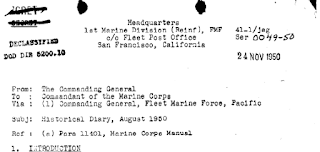 |
| Bruce's first enlistment photo from 1936. |
One of the thrills from historical research comes from running down the answer to an unanswered question. I am wrestling with one such question regarding Bruce's service, and hunting down answers to it gave me a chance to better understand the nature of the beginning of the Korean War.
Bruce served a long Marine career. In fact, his career spanned four enlistments: 1936, 1942, 1946, and 1950. Here's a photo from his final enlistment document.
 |
| This reenlistment is dated approximately one month before America entered the Korean War. |
As one can see, the letterhead from this document indicates he was with the 2nd Marines. However, all documents related to his death indicates that he was with the 1st Marines as part of the 1st Marine Division.
 |
| From a report on Bruce's death. |
This is a detail I might have not really comprehended when first scanning the large OMPF for Bruce. But after scanning it I talked a bit with my brother, Matt, who served with the Marines earlier this century. Matt has been very helpful for clarifying fussy but important details. For instance, in Lauren's project last year he helped me understand what a RCT was. A specific question he was able to help me with this time around was FMF (which means Fleet Marine Force). But as we talked more about Bruce's service, he responded that something I said didn't make sense: Why would a fellow in 2nd Marines be in the First Marine Division?
 |
| A declassified report that I found online. |
I started hunting. Marine history indicates that the 2nd Marine Division saw no major action in the Korean War. In fact, between 1945 and 1958 they were never deployed. But Bruce most certainly was. Apparently, at some point, Bruce was transferred to the 1st Marines, 1st Marine Division.
Perhaps there's a document in his OMPF that indicates the transfer. I haven't caught it yet.
This became a pretty fun mission, figuring out how a Marine who reenlisted with a unit stationed in Parris Island that never saw action in Korea ended up dying in service in Korea just six months after reenlisting. Eventually, I found something quite useful: an out-of-print narrative of the Korean War written by Robert Leckie. I found the PDF of it on the National Archives website.
 |
| Robert Leckie |
Does that name sound familiar? Perhaps not. Robert Leckie was a World War II Marine who wrote one of my favorite wartime memoirs, A Helmet for My Pillow. He was also featured in the HBO series The Pacific. I didn't know he had written a history of the Korean War, too.
His account of the Korean War proved to be a fine piece to read. From it I learned a lot about the dramatic mobilization of U.S. forces in the Korean War. In the wake of World War II, our military dropped a great deal in size. The Marines were, by June of 1950, a shell of what they had been in World War II. Neither the Marines nor the Army had numbers adequate to defend South Korea. And in many ways, raising a Marine force in time to turn the tide of the Korean War was something of a miracle.
In the summer of 1950 there was a dramatic series of events. The Marines made it a priority to build the First Division up to combat strength: it grew from about 8,000 to 25,000 in less than three months. The Marine Reserves were called up. Many of these men were civilians enjoying a civilian life who had served in World War II. The Marines also resorted to "cleaning out embassies and naval stations from all over the world" to build up this force. Many active duty Marines were transferred from the 2nd Division to the 1st.
Bruce was one of them.
Reading Leckie's account, it reminded me of how Matt said that the Marines were so rushed getting men over there that basic training was done on the troop ships.
Once put together, the group participated in the Inchon landings, an amphibious assault that took place in conditions so unfavorable it should never have worked. They went on to liberate Seoul and penetrate deep inside North Korea.
Then, of course, this division fought one of the most famous campaigns ever against enormous numbers at Chosin Reservoir.
Bruce was part of that story.
What did Bruce know when he signed up for that fourth enlistment? Did he know a war was around the corner? Did he know he'd end up serving a different unit in that war? Did he know he'd be deployed to Asia for the second time in his career, and overseas for the third? This man's career keeps becoming more fascinating every time I follow some thread to the ground.
Comments
Post a Comment